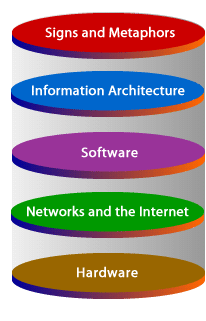| Lesson 2 | Web Interaction Model |
| Objective | Review the Web Interaction Model |
Review the Web Interaction Model
In the domain of web design, the Web Interaction Model (WIM) delineates the communication process that occurs between a user and a web-based application. This model provides a conceptual framework to understand how the different elements interact in the web environment, aiding designers in creating more efficient, user-friendly web interfaces. The primary elements of the Web Interaction Model are:
By understanding the interplay of these elements, designers can better shape the web interaction experience, optimizing aspects such as usability, accessibility, performance, and overall user satisfaction. The Web Interaction Model provides a comprehensive overview of how information flows and transformations occur in the web environment, enabling informed design decisions for enhanced user experiences.
- User: This is the individual who interacts with the web-based application. The user operates the user agent, typically a web browser, to interact with the application. It's essential to understand the user's needs, behavior, and context of use to design an effective web interface.
- User Agent (Browser): The user agent, usually a web browser like Google Chrome or Mozilla Firefox, acts as an intermediary between the user and the web application. It interprets and renders the information sent by the web application in a format that the user can interact with, and it takes user inputs to send back to the server.
- Web Application: This refers to the server-side application that processes the user's requests and responds accordingly. Web applications range from simple static websites that serve HTML pages to complex, dynamic web applications that provide a multitude of services, such as e-commerce sites, content management systems, or social networking sites.
- HTTP Protocol: The Hypertext Transfer Protocol (HTTP) is the foundation of any data exchange on the Web. It's a protocol used for transmitting hypermedia documents, such as HTML. It's a request-response protocol: when a user, via the user agent, requests a specific resource, the web application processes the request and responds with the requested data.
- Webpage/Interface: The webpage or interface is what the user interacts with. It's the visual and functional output of the web application as rendered by the user agent. This can include various forms of content like text, images, video, and interactive elements.
- User Inputs: These are the actions the user performs to interact with the web application. This could be clicking on links or buttons, typing into text fields, selecting options from menus, or a variety of other interactions. The user agent sends these interactions to the web application via HTTP requests.
By understanding the interplay of these elements, designers can better shape the web interaction experience, optimizing aspects such as usability, accessibility, performance, and overall user satisfaction. The Web Interaction Model provides a comprehensive overview of how information flows and transformations occur in the web environment, enabling informed design decisions for enhanced user experiences.
The Web Interaction Model provides you with one way of understanding how Web processes work together.
This model accounts not only for hardware, software, and networks, but also for the user's experience. The Web Interaction Model is based on the idea of a series of layers operating dynamically, with each layer responding to input and data from the other layers.
The following diagram illustrates the Web Interaction Model: This model accounts not only for hardware, software, and networks, but also for the user's experience. The Web Interaction Model is based on the idea of a series of layers operating dynamically, with each layer responding to input and data from the other layers.
 <
/amp-img>
<
/amp-img>
Awareness Without Advertising
Limitations of the Web Interaction Model
You should keep in mind that there is overlap between the layers of the model. Each layer represents a discrete element of the Web.
In some cases, elements support the layers above them, but in all cases, each layer is affected by the others.
This model makes distinctions among the elements of the Web, so you can consider your options for each element independently when you are clarifying your Web site needs. Your organization's business goals should drive the choices made at each layer.
When planning a Web site, do not fall into the trap of looking at only one element.Careful planning for website is priceless.
Consult all team members for input in their area of expertise. End user satisfaction is affected by every component and layer of your Web site.
The next lesson provides a review of the Web Development Process Model.
This model makes distinctions among the elements of the Web, so you can consider your options for each element independently when you are clarifying your Web site needs. Your organization's business goals should drive the choices made at each layer.
When planning a Web site, do not fall into the trap of looking at only one element.Careful planning for website is priceless.
Consult all team members for input in their area of expertise. End user satisfaction is affected by every component and layer of your Web site.
The next lesson provides a review of the Web Development Process Model.